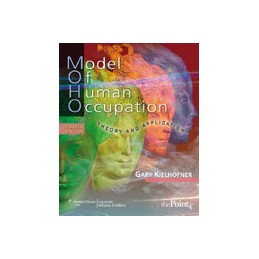Model of Human Occupation, Fourth Edition offers a complete and current presentation of the most widely used model in occupational therapy, and delivers the latest in MOHO theory, research, and application to practice. This authoritative text explores what motivates individuals, how they select occupations and establish everyday routines, how environment influences occupational behavior, and more.
NEW TO THIS EDITION::
- Case Vignettes that illustrate key concepts that students need to know
- Case Studies that help students apply the model to practice
- Chapter on evidence based practice (ch. 25)
- Chapter on World Health Organization and AOTA practice framework and language links the MOHO model to two widely used frameworks (ch. 27)
- Photographs of real patients help bring the concepts and cases to life//ulBR//DIV>
Chapter 1:: Introduction to the Model of Human Occupation- Section 1:: Explaining Human Occupation
- Chapter 2:: The Basic Concepts of Human Occupation
- Chapter 3:: The Dynamics of Human Occupation
- Chapter 4:: Volition
- Chapter 5:: Habituation:: Patterns of Daily Occupation
- Chapter 6:: Performance capacity and lived body
- Chapter 7:: The Environment and Human Occupation
- Chapter 8:: Dimensions of Doing
- Chapter 9:: Crafting Occupational Life
- Chapter 10:: Doing and Becoming:: Occupational Change and Development
Section 2 Applying MOHO:: The Therapy Process and Therapeutic Reasoning - Chapter 11:: Therapeutic Reasoning:: Planning,Implementing and Evaluating the Outcomes of Therapy
- Chapter 12:: Assessment:: Choosing and Using Structured and Unstructured Means of Gathering Information
- Chapter 13:: Occupation Engagement:: How Clients Achieve Change
- Chapter 14:: Therapeutic Strategies for Enabling Clients
Section 3:: Assessments:: Structured methods for Gathering Client InformationChapter 15:: Observational Assessments Chapter 16:: Self-Reports:: Eliciting Clients PerspectivesChapter 17:: Talking With Clients:: Assessments That Collect InformationChapter 18:: Assessments Combining Methods of Information Gathering
Section 4:: Case IllustrationsChapter 19:: Recrafting Occupation NarrativesChapter 20:: Applying MOHO to Clients Who Are Cognitively ImpairedChapter 22:: Enabling Clients to Reconstruct Their Occupational Lives in Long-Term Settings
Section 5:: Resources for Applying and Developing MOHOChapter 23:: Communication and Documentation Chapter 24:: Program Development Chapter 25:: Evidence for Practice from the Model of Human OccupationChapter 26:: Research:: Investigating MOHO Chapter 27:: The Model of Human Occupation, the ICF, and the Occupational Therapy Practice Framework:: Connections to Support Best Practice Around the World.
Appendix A:: BibliographyAppendix B:: Introduction to the MOHO Clearinghouse and Web Site




 Delivery policy
Delivery policy
 Security policy
Security policy
 Return policy
Return policy
